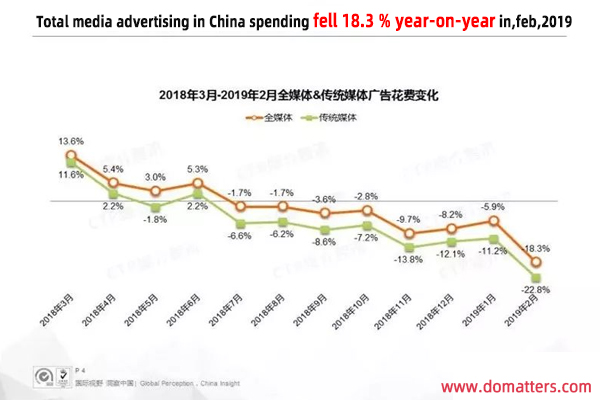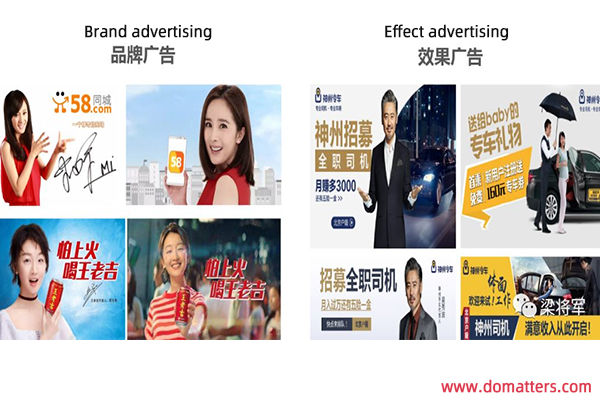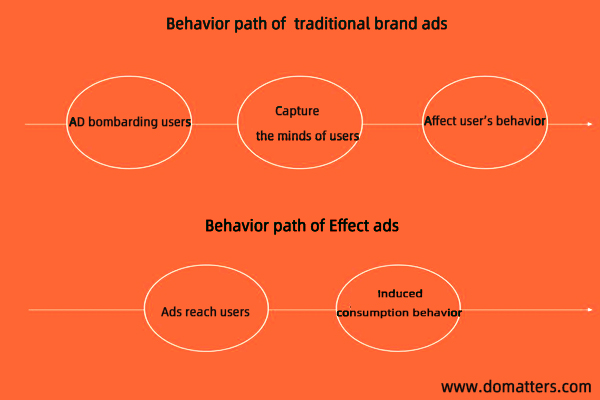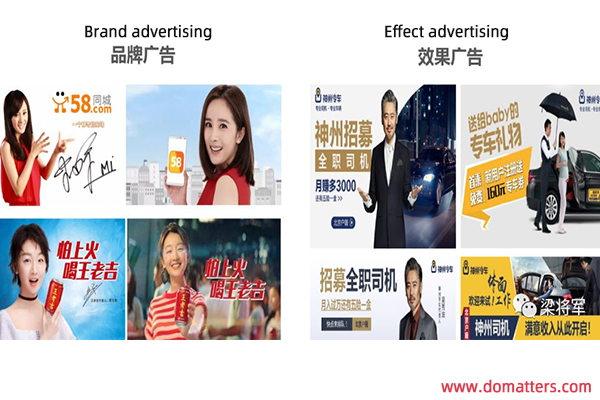The traditional brand person should establish “thinking of Effect advertising” positively.Use the methodology of brand and effect synergy to promote the integration and progress of the advertising industry.
The world has entered the era of AI, big data and algorithm, but our marketing is still in the age of steam.Although the technical change of marketing is not a day, but our marketing thinking transformation must be “insight”.Because if you don’t have a brain, how can you talk about technology?Domatters believes that history will rule out brands that don’t have an “thinking of Effect advertising” .
The professors of Wharton conducted an experiment on “advertising” to find out how to get people to eat more fruits and vegetables.They divided the subjects into two groups and showed them different slogans:
1. Healthy life, five kinds of fruits and vegetables every day;
2.On your restaurant plate,put five fruits and vegetables every day.
Which of these two slogans is better?I think almost everyone’s first response is number one, which is the same thing as the experiment.But let’s put it another way: which of these two slogans is more effective?The result would be a reversal of what most people think.
People who read the first item did not change their eating behavior.Those who only read “on a restaurant plate, five fruits and vegetables every day” increased their daily fruit and vegetable intake by 25 percent!
More interestingly, most people said the second slogan was “too corny” and said the “corny” AD would never affect their behavior.But they were soon confronted by a large “true fragrance” scene.
This experiment is a big warning to all advertisers: what we think is a good idea is often ineffective.In recent years, advertisers have become more and more adept at making “moving ads” and “refresh ads”, but “effective ads” have become their weakness.
In 2019, “economic downturn” is often used as a business term. The result that we can see with the naked eye is that in 2019, the all-media advertising in China will fall off a cliff for the first time.In such an environment, every brand owner has changed from a “long-termist” to a “quick buck” businessman who wants to see a return on every penny they spend.

In fact, we all know that it is impossible to only do Effect advertising, and do not do brand image investment.Spending only on effective advertising is a stopgap measure in an economic downturn.
Today,Domatters is going to share that how to use effect ads thinking for brand advertising so that we can engage with the methodology of brand and effect synergy to make our advertising more effective.
Brand ads VS Effect ads
Brand advertising: advertising input is to occupy the minds of consumers, so that consumers can think of you the first time when they have a demand;
Effect advertising: the pursuit of advertising is immediate user transformation, so that what you see is what you buy.

Although the ultimate goal of all advertising is to sell, the path of realization may vary.To take a simple example, two girls fall in love with a handsome boy.One girl’s caring behavior makes his heart beat and makes him willing to marry her, which is called brand advertising.Another girl dressed up to let him impulse, lure him to fall on their own, which is called Effect advertising.They may all get the handsome guy, but one wins the heart and then the body, and the other wins the body.Therefore, brand advertising is “go heart”, Effect advertising is “go kidney”.
The ‘heart to heart’ of brand ads make relationships last longer, but win over people for a long time;”Kidney to Kidney” of Effect advertising effect quickly, but because there is no emotional basis, the other side often “unfeeling”.That is why there is a proposal for “unity of brand and efficiency” in the industry.It sounds nice for “unity of brand and efficiency”, but the reality is tough.Many advertisers reject this concept because kpis of brand advertising and Effect advertising cannot be “integrated”.It’s impossible to say that we’re paying for the number of people who sign up by scanning a poster.We could not have invested in a wave of promotion advertisements on taobao, and then measured the increase of brand first mentions.
So,Domatters thinks that “unity of brand and efficiency” is a misleading word.It would be more accurate to call it “synergy of brand and effect” at this stage.However, “synergy of brand and effect” is not to integrate KPI, but to integrate quality and Effect advertising in thinking.
Why is there such a outcome as effective advertising?
Twenty years ago, there was no difference between “brand advertising” and “Effect advertising” in China.All advertising is brand advertising and all advertising is also Effect advertising.
Why did the market grow so quickly once the ads appeared on TV?The fundamental reason is that the Internet was not developed in those days, and information shaped the human brain in a different way.But after the arrival of the Internet, in an era of fragmented and transparent information, it is too difficult to occupy a person’s mind.People even hadn’t digested last night’s TV series “all good”, who can have another mind to remember a cold brand.Effect advertising solves this problem by shortening the path through which an AD can trigger an effect.The operating time of independent thinking is 7 seconds, once more than 7 seconds, people have rational judgment.The power of effective advertising is not to give you the time to think, click can be immediately consumed.
Then, as big data and algorithms improved, machines learned more about people.The systems of Effect advertising are becoming ever more accurate at finding the real consumer, solving the advertising industry’s historical conundrum of “I know half the ads are wasted, but I don’t know where”.
With the upsurge of Internet entrepreneurship, e-commerce, games, social apps and other apps are springing up. They rely more on online user transformation than traditional brands such as cosmetics and drinks, which further drives the development of effective advertising.
What kind of thinking is effective advertising thinking?

Effective advertising thinking is not equal to effective advertising.Effective advertising is the real network natives, it has some more technical advertising thinking which is worth our brand for their own use.There are three ways of thinking about effective advertising: dynamic optimization, user-centered, and relevance.This is worth the brand advertiser to study earnestly.
-
static VS dynamic
There is a “test period” before the Effect advertising launched, which will test which version of material and copy is more attractive to users with the minimum budget, and test whether the targeted user group is interested in the product advertisement at the initial stage.The AD is in small trial and error, adjust ceaselessly, optimize, till find an AD pattern that is approbated by the user, just put big budget go down next.
When brand advertising is a big success, brand owners often make two decisions:
A.The idea was a success.Let us copy it again;
B.Estimate user aesthetic fatigue, we change the pattern!
Well, whether you choose A or B, that’s the wrong answer.If you choose A, any case is difficult to copy in the advertising field, because the peer will follow suit and the user will lose the freshness.If you choose B and change to a new position, everything will be cleared again, and all the brain storms will be experienced again.
Therefore, excellent people usually choose C, and the next advertisement will be based on this one to innovate iteratively.Effect advertising has always adhered to this concept that the current advertising is to present better advertising in the future.
Therefore, brand advertising is often a one – off business and often want to “bi qi gong in a battle”.But the effect advertisement pursues “the trial and error and the optimization”, progresses unceasingly in the process.The former is a static thinking, the latter is a dynamic thinking.This “static thinking” of brand advertising brings great uncertainty to the project, and also makes the relationship between advertisers and agencies tense and fragile.
-
Product-oriented VS user-oriented
From the perspective of content material, brand advertising tends to be product-oriented, while Effect advertising tends to be user-oriented.
Brand advertising is mostly about trying to leave a clear brand mark on consumers, such as brand USP, brand positioning, brand selling point and so on.Then it will let consumers remember the good brand through continuous repetition and creative stimulation, so that they can think of themselves in the first time when they consume.
The biggest difference with effective advertising is that it is not trying to create an impression, but trying to induce your consumption action.Most of the time, the origin of its thinking is not what the brand should be, but what the user will be eager to consume a brand in what scenario and in the state of mind.
For example, brand advertising and Effect advertising in the face of the same customer, the output of the material is not the same.
Customer: a cosmetics brand
Function: whitening
Selling point: free of all chemicals, natural whitening, with better results
Region: third-tier and fourth-tier cities
Faced with such a brief, the creativity of brand advertisement will write such a copy:
The natural whiteness shapes the natural you
— ###, natural whitening, better effect
Faced with the same brief, the operation of Effect advertising may write such a copy:In the first and second tier cities, little sisters are using whitening magic tools.
We can say “natural white, shape the natural you”, this sentence from the point of view of the product which is said the selling point of the product and the interests of users.And “natural you” the four words back to consumers of a natural beauty yearning;
However, the copy of “whitening products used by little sisters in first-tier and second-tier cities” has no concerns about the products at all. Its insight perspective is that “although third-tier and fourth-tier consumers have upgraded their consumption, they still have a deep sense of inferiority when facing first-tier and second-tier consumers, thinking that first-tier and second-tier consumers represent a more fashionable lifestyle.
Therefore, the copywriting of Effect advertising is not so much insight into the user, but rather insight into human nature, the call of knowledge is consumer psychology.
Domatters want to tell you that having a brand identity for a product is not the same thing as having a consumer impulse for a product.
-
Causality VS correlation
Since ancient times, our thinking about truth has been about cause and effect.As a cause, so a fruit.What kind of effect, there is a corresponding cause.
The rise of big data and algorithms has given us a whole new way of thinking about what can solve problems without knowing why.This way of thinking is called “relevance” thinking.For example, putting beer and diapers together has magically increased sales on both sides.A supermarket discovered a 17-year-old girl’s pregnancy from her shopping list.
Effect advertising is an advertising model that relies heavily on algorithms and data.Only with the help of big data and algorithm platform,it can help advertisers accurately to find the target population.So,we’ve learned to think about advertising with relevance with the help of machines.
For example,how does brand thinking and effect thinking treat the target consumers when we look at the brief of a high-end home decoration service?
Products: villa, luxury decoration custom
Group: business owners, golden collar and other ultra-high income groups
Location: China’s core cities have stores
The biggest difficulty of this brief lies in: the client’s products are too high-end, and the consumers who can afford villa decoration are all social elites, whose catalytic habits are hard to grasp.On the one hand, we can not be observed in daily life, unless the advertiser is a rich second generation.On the other hand, we seldom see relevant researches in the third-party data.
Traditional brand advertisers think, “how do you find these high net worth individuals?”
This group of people may be more business-oriented class, the usual travel time more.So airport advertising, in-flight magazine advertising is a good choice.They may hang out in the business building when they talk business.So such as Beijing CBD near the building elevator advertising can be considered.Business people are generally concerned about finance and economics, current political news, so can be in phoenix, netease and other news clients on the financial channel to do some advertising.
The above media strategies are based on causality, that is, where the target population most often appears, our media advertising will be placed.
An effective thinking AD considers the brief in a different way to solve the problem:
A.Find the seed users.We might start with a small budget for AD placement, where we see which users actually click on the AD and generate customer inquiries or purchases.
Perhaps we put in a circle of surprised to find that the real interested in villa decoration is not the boss of the enterprise, but the boss’s wife.They don’t travel to the airport at all, or to high-end office buildings.They often visit overseas online shopping on taobao or JD and go to nail salons every month.
B.Find more users through relevance.If these “rich wives” are the target group, it doesn’t mean we need to advertise around nail salons or market on JD or taobao.Because consumer behavior is constantly changing, they’re at the nail salon today, they’re at the coffee shop tomorrow afternoon.
We’re going to compare the rich ladies to the big data Banks of the media and try to find commonalities in their behavior.Once they found that their behavior was very similar, for example, they searched for LV three times in three months and sent her advertisements.
The application of effective advertising thinking in brand advertising
At least three scenes of brand advertising can be optimized with the effect of advertising thinking.
-
redefine the target population
Throughout the history of advertising, we have defined consumers in seven dimensions: age, sex, income, occupation, education, marriage and geography.For example, a clothing brand will describe its consumer group to an advertising company as follows: our population is mainly female, aged between 25 and 35, with a college degree, typical middle class white-collar workers, and unmarried people in the first and second-tier cities.
This portrait of the consumer, defined by man’s “natural attributes”, is almost indistinguishable from the way the census is recorded.But consumers are people, not museum specimens, and people’s consumption will change with the environment, with the mood.Therefore, the biggest problem in defining consumers with “natural attributes” is that we can only describe the outline of the group of consumers and cannot get individual differences of consumers.We can only grasp the long-term characteristics of consumers, but not the immediate behavior of consumers.
If we re-examine this issue with the thinking of effect advertising, we will enter another world.For example, if you are the electrical appliances of Laoban, a high-end kitchen electrical brand, how to define their own consumers?
Traditional brand advertising thinking will be defined as follows: 25-45 years old middle class family, female, mostly in the provincial capital city.
But the effect advertisement thinks a problem first: “What circumstance can consumer buy lampblack machine, gas stove such hutch electric product?”.The first thing that comes to mind is the scene of newlywed.
Because kitchen electricity is a low-frequency consumer product, people buy it once or twice in their lifetime, and most of their first purchases are when they get married.And “newly-married” close it is “domestic outfit”, “buy a room”, again meticulous point cent still has “furniture choose and buy”, “honeymoon travel” etc.This is the typical thinking of “relevance” , with associated behavior labels to define our target consumers.We will also test the hypothesis in the early stage of advertising, to see who is the real user of the purchase, what other characteristics.In the actual advertising, we constantly refine the crowd portrait, adjust the target group strategy, which also uses the thinking of “dynamic”.
-
explore the pros and cons of ideas
Advertisers create a good idea, using the tool is “insight” which is to grasp their emotional pulse and consumer pain points through the perception of consumers.However, there is often a thin line between “insight” and “slap on the head”. Therefore, the popularity of advertising ideas is often not recognized by advertisers in advance.Although in the traditional advertising production process, we will also start a small range of research before the launch, but user research and real user feedback is often inconsistent.
If we use the operational mode of effect advertising, we can reduce the risk of creativity in some cases.This approach, called the “A/B test” in effect ads, is to put A few different types of AD ideas online at the same time for A small fee to see how users react to different groups of ideas.
If we had three commercials to test, the data might look like this:
A. exposure 140,000 , 20% interaction rate, 10% conversion rate
B. exposure 200,000, interaction rate 50%, conversion rate 5%
C. exposure 130,000, interaction rate 20%, conversion rate 35%
From this data, we can draw the following conclusion:
C is an advertisement with goods, which has a very high conversion rate and is suitable for peak season promotion.B is a highly discussed advertisement, which is suitable for social promotion and attracts users’ attention.A’s overall performance is mediocre, and the reason needs to be found out and optimized.
-
explore the consumption scenarios of products
All products are produced to meet the needs of users.Consumers may choose a product because of looks, smells, a memory, or just because a friend happens to be using it…Users’ needs are not the same as their reasons for buying you.Knowing what consumers actually buy makes sense not only for selling, but also for rethinking brand strategy.
Let’s take brain gold in China as an example.The product of brain platinum is to improve morpheus actually, but hit on advertisement material however “gift”.Its reason is that shi yuzhu found that the old people have sleep problems in his market visit.But old people are reluctant to spend money on health care products.Health care products are filial piety children parents.So this just had a super screen more than ten years of advertising “send brain platinum gift”.
In the Internet era, we don’t need to visit the fields like Mr. Shi. We can explore the real consumer psychology of users and discover the real consumption scenes of products by means of effective advertising.
The general operation of effective advertising is to find the advertising mode that can trigger the consumption behavior of users the most by constantly changing the material manually and constantly optimizing the algorithm through the machine.In this process, we can not only sell goods and get customers, but also identify the triggers of consumer behavior.
When we know more clearly why consumers will buy us, we also know which direction the brand will go.
Hope this blog can help you.Read more information,please contact Domatters.










